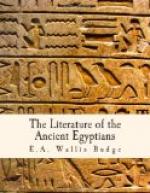Certain of the Chapters of the Book of the Dead (e.g. XXXB and LXIV) were written in the city of Thoth, or Khemenu, others were written in Anu, or Heliopolis, and others in Busiris and other towns of the Delta. Of the Book of the Dead that was in use under the fifth and sixth dynasties we have no copies, but many Chapters of the Recension in use under the eleventh and twelfth dynasties are found written in cursive hieroglyphs upon wooden sarcophagi, many of which may be seen in the British Museum. With the beginning of the eighteenth dynasty the Book of the Dead enters a new phase of its existence, and it became the custom to write it on rolls of papyrus, which were laid with the dead in their coffins, instead of on the coffins themselves. As the greater number of such rolls have been found in the tombs of priests and others at Thebes, the Recension that was in use from the eighteenth to the twenty-first dynasty (1600-900 B.C.) is commonly called the THEBAN RECENSION. This Recension, in its earliest form, is usually written with black ink in vertical columns of hieroglyphs, which are separated by black lines; the titles of the Chapters, the opening words of each section, and the Rubrics are written with red ink. About the middle of the eighteenth dynasty pictures painted in bright colours, “vignettes,” were added to the Chapters; these are very valuable, because they sometimes explain or give a clue to the meaning of parts of the texts that are obscure. Under the twentieth and twenty-first dynasties the writing of copies of the Book of the Dead in hieroglyphs went out of fashion, and copies written in the hieratic, or cursive, character took their place. These were ornamented with vignettes drawn in outline with black ink, and although the scribes who made them wrote certain sections in hieroglyphs, it is clear that they did not possess the skill of the great scribes who flourished between 1600 and 1050 B.C. The last Recension of the Book of the Dead known to us in a complete form is the SAITE RECENSION, which came into existence about 600 B.C., and continued in use from that time to the Roman Period. In the Ptolemaic and Roman Periods the priests composed several small works such as the “Book of Breathings” and the “Book of Traversing Eternity,” which were based upon the Book of the Dead, and were supposed to contain in a highly condensed form all the texts that were necessary for salvation. At a still later period even more abbreviated texts came into use, and the Book of the Dead ended its existence in the form of a series of almost illegible scrawls traced upon scraps of papyrus only a few inches square.
Rolls of papyrus containing the Book of the Dead were placed: (1) In a niche in the wall of the mummy chamber; (2) in the coffin by the side of the deceased, or laid between the thighs or just above the ankles; (3) in hollow wooden figures of the god Osiris, or Ptah-Seker-Osiris, or in the hollow pedestals on which such figures stood.




